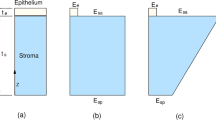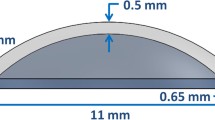Abstract
We setup a mechanically based finite element model to evaluate the change in the shape of the human cornea induced by ablation of stromal tissue. By considering the deformability of the cornea, the model computes the change of the dioptric power resulting from ablative laser surgery. We use a previously developed 3-D finite element model of the human cornea (Pandolfi and Manganiello in Biomech Model Mechanobiol 5:237–246, 2006). The solid geometry is discretized into finite elements by an automatic procedure which recovers the unloaded configuration. The geometry is defined in parametric form and can be characterized by individual geometrical data when available. A two-fiber reinforced hyperelastic material model, which accounts for the organization of the anisotropic collagen structure, is adopted to describe the stromal tissue. For the simulation of laser refractive surgery of myopic and astigmatic eyes, a geometrical correction of the corneal profile is included into the code. We show two examples of application of the model to the reshaping of a myopic and an astigmatic eye. Numerical results provide the postoperative shape of the cornea, the corrected refractive power, and the distribution of the stress throughout the stromal tissue.









Similar content being viewed by others
References
Jackson WB (2004) Photorefractive keratectomy: indications, surgical techniques, complications, and results. In: Bille JF, Harner CFH, Loesel FH (eds) Aberration free refractive surgery. New frontiers in vision. Springer, New York, pp 213–227
Hersh PS, Scher KS, Irani R (1998) Corneal topography of photorefractive keratectomy versus laser in situ keratomileusis. Summit PRK-LASIK study Group. Ophtalmology 105:612–619
Taneri S, Zieske JD, Azar DT (2004) Evolution, techniques, clinical outocomes, and pathophysiology of LASEK: review of the literature. Surv Ophthalmol 49(6):576–598
Pandolfi A, Manganiello F (2006) A model for the human cornea: constitutive formulation and numerical analysis. Biomech Model Mechanobiol 5:237–246
Holzapfel GA, Gasser TC, Ogden RW (2000) A new constitutive framework for arterial wall mechanics and a comparative study of material models. J Elast 61:1–48
Cano D, Barbero S, Marcos S (2001) Comparison of real and computer-simulated outcomes of LASIK refractive surgery. J Opt Soc Am A 32:239–249
Schwiegerling J, Snyder R (1998) Custom photorefractive keratectomy ablations for the correction of spherical and cylindrical refractive error and higher-order aberration. J Opt Soc Am A 15:2572–2579
Alastrué V, Calvo B, Peña E, Doblaré M (2006) Biomechanical modeling of refractive corneal surgery. J Biomech Eng 128:150–160
Pinsky PM, van der Heide D, Chernyak D (2005) Computational modeling of mechanical anisotropy in the cornea and sclera. J Cataract Refract Surg 31:136–145
Manganiello F, Fotia G, Pandolfi A (2007) Numerical evaluation of the mechanical response to laser refractive corneal surgery (submitted)
Mandell RB, St Helen R (1971) Mathematical model of the corneal contour. Br J Physiol Opt 26:183–197
Manns F, Ho A, Parel J, Culbertson W (2002) Ablation profiles for wavefront-guided correction of myopia and primary spherical aberration. J Cataract Refract Surg 28:766–774
Boote C, Dennis S, Newton RH, Puri H, Meek KH (2003) Collagen fibrils appear more closely packed in the prepupillary cornea: Optical and biomechanical implications. Invest Ophthalmol Vis Sci 44(7):2941–2948
Boote C, Dennis S, Huang Y, Quantock AJ, Meek K (2005) Lamellar orientation in human cornea in relation to mechanical properties. J Struct Biol 149:1–6
Daxer A, Fratzl P (1997) Collagen fibril orientation in the human corneal stroma and its implication in keratoconus. Invest Ophthalmol Vis Sci 38:121–129
Newton RH, Meek KM (1998) The integration of the corneal and limbal fibrils in the human eye. Biophys J 75:2508–2512
Newton RH, Meek KM (1998) Circumcorneal annulus of collagen fibrils in the human limbus. Invest Ophthalmol Vis Sci 39:1125–1134
Meek KM, Fullwood NJ (2001) Corneal and scleral collagens—a microscopist’s perspective. Micron 32:261–272
Treloar LRG (1975) The physics of rubber elasticty. Clarendon Press, Oxford
Holzapfel GA (2000) Nonlinear solid mechanics: a continuum approach for engineering. Wiley, New York
Anderson K, El-Sheikh A, Newson T (2004) Application of structural analysis to the mechanical behavior of the cornea. J R Soc Interface 1:1–13
MacRae S (1999) Excimer ablation design and elliptical transition zones. J Cataract Refract Surg 25:1191–1197
Schwiegerling J, Snyder R, MacRae S (2001) Optical aberrations and ablation pattern design. In: Customized corneal ablation: the quest for super vision. Slack Inc., Thorofare, pp 96–107
Munnerlyn C, Koons S, Marshall J (1988) Photorefractive keratectomy: a technique for laser refractive surgery. J Cataract Refract Surg 14:46–52
Gatinel D, Hoang-Xuan T, Azar DT (2001) Determination of corneal asphericity after myopia surgery with the excimer laser: a mathematical model. Invest Ophthalmol Vis Sci 42:1736–1742
Jiménez J, Anera R, Jimémez del Barco L (2003) Equation for corneal asphericity after corneal refractive surgery. J Refract Surg 29:65–69
Smith G, Atchison DA (1997) The eye and the visual optical instruments. Cambridge University Press, Cambridge
Acknowledgments
This research has been carried on the Italian MIUR-Cofin2005 programme “Interfacial resistance and failure in materials and structural systems”. For his stay at Caltech during the spring 2005, FM acknowledges the financial support of the Doctoral School of the Politecnico di Milano and the kind hospitality of Michael Ortiz. GF gratefully acknowledges the support of Regional Authorities of Sardegna.
Author information
Authors and Affiliations
Corresponding author
Appendix
Appendix
The second Piola-Kirchhoff stress tensor S and the Cauchy stress tensor \(\varvec{\sigma}\) are given by
The stress tensor S decouples in the form
where
Rights and permissions
About this article
Cite this article
Pandolfi, A., Fotia, G. & Manganiello, F. Finite element simulations of laser refractive corneal surgery. Engineering with Computers 25, 15–24 (2009). https://doi.org/10.1007/s00366-008-0102-5
Received:
Accepted:
Published:
Issue Date:
DOI: https://doi.org/10.1007/s00366-008-0102-5




